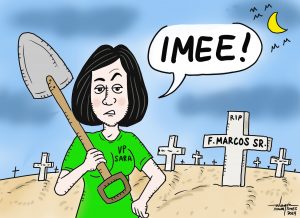 Indeed Davao City still remains the “Lucky One” in Mindanao and probably the entire country.
Indeed Davao City still remains the “Lucky One” in Mindanao and probably the entire country.
Imagine, while almost every city and province in Mindanao and the Visayas is devastated by raging flood water shortly before Christmas and until this week, Davao City remains relatively unscathed by the wrath of excess rains despite the fact that the city is also affected by the continuing bad weather brought about by the existence of low pressure areas east of the Davao Region.
Yes, on Christmas Day heavy rains poured in the city the whole afternoon and lingered on until evening. The succeeding days were also gloomy and intermittent downpours occurred. But these were not enough to cause the swelling of the city’s major waterways like Davao River, Talomo River, Lasang and Bunawan Rivers, Lizada River, the Matina Pangi creek and all other tributaries.
The result of course is the absence of flood in the city’s downtown area and in nearby lowlands within the peripheries of the city’s urban center. This exceptional feat of the city should never be cause for complacency of our officials. They should not stop thinking and implementing ways to obviate the possibility that what is happening now in some cities and provinces in the Mindanao island will not occur in this place.
Our officials as well as our people should not content themselves that we will remain protected from the hazards of being hit by strong rains and even storms that may evolve from the existence of low pressure areas or LPA that normally comes east of the Davao Region.
Recent history will tell every Davaoeno borned in the 80s and are still up and about until now, that there were at least three major floods in the city that caused heavy damage to lives, infrastructures and properties. First that we could recall was the one in 1994 when the central Mintal area was inundated and the remaining rice lands of the city – Los Amigos – were submerged in floodwater rushing in from the high grounds of Baguio district.
Then we recall that sometime at the end of 2001 rains both in the city proper and in all the surrounding mountainous barangays caused all the major rivers we have earlier mentioned here to overflow. The resulting flood was all over the plains within the vicinity of the swelling rivers.
The last that we can remember as one of the most disastrous floods in terms of lives lost was the one that happened sometime in June of 2011. The Matina Pangi River also known as the Balusong River overflowed after heavy rains hit the Calinan and Tugbok districts all day and night long. It brought serious destruction in Matina Crossing, Bangkal and nearby areas including Matina Aplaya. In fact a second hand car that we used to own and was under minor repairs in a shop at Km. 6 along MacArthur highway ended up washed away a few meters from where it was parked inside the shop compound. It took us a substantial amount of money to have it back in running condition.
The years in between those nature’s rage were minor floods did happen but affected only certain specific areas of the city. That is the flooded places are isolated only and the damage incurred containable. Nevertheless, the inconveniences brought about by those isolated floods were unimaginable to those directly affected residents.
However, with the magnitude of the flood that are devastating several places in Mindanao these days we can only thank nature’s creator for sparing the city from destruction. Davaoenos are indeed as lucky as their city.
************************
Anytime soon this year the second nail of the crucifixion of the Davaoenos will be driven.
We are referring to the second tranche of the implementation by the Davao City Water District (DCWD) of its staggered 60 percent rate hike granted by the Local Water Utilities Board without a whimper of protest from the city government that is supposed to look after the welfare of its constituents.
The first and largest nail in the crucifixion of water consumers was driven (implemented) last year. It was 30 percent of the 60 percent approved increase. In an announcement proudly made by the water firm’s communications department the other day, the city residents were advised that soon this year the second tranche of the rate increase equivalent to 20 percent will be applied in the billing.
As we said earlier that hike will be the second nail to be driven at a time when people are not even half way from their recovery efforts after getting economically brought down on their knees by the CoViD 19 pandemic.
But what we feel water consumers should be wary about is where will the 20 percent rate hike be based, from the current water rate or from the existing rate when the DCWD petition for increase was made and eventually approved? We believe the people of the city deserve a clarification on this. Our take is that it would be extremely unfair and synonymous to cheating the consumers if the basis of the 20 percent hike is the current rate per cubic meter and not the one when the petition was deliberated and eventually approved by the LWUA.
We wonder if there is still any remnant of the once activist consumer group Konsumo-Davao to look into this issue. The people certainly are badly need their help now, di ba Bai Wennie, Councilor Braga?
This is one of those times that Davaoenos badly miissed the late Rey Magno Teves.

